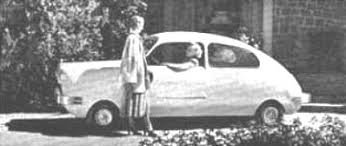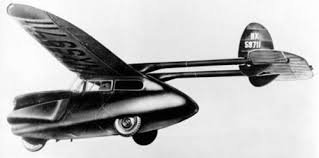Take to the Air in an Airways
/Advanced technology, low price, new materials, and alternative engineering; would-be carmakers tried a all of these approaches to gain a foothold in the exploding postwar car market. T. P. Hall, the man behind Airways Motors decided to attack it from the air.
Theodore Parsons Hall took a roundabout route to becoming a carmaker. After earning an engineering degree in 1931 at the Massachusetts Institute of Technology, he went on to work for Consolidated Vultee Aircraft Corporation (CONVAIR) out in San Diego. He eventually became chief development engineer on first the PBY Catalina maritime reconnaissance plane, and then the B-24 Liberator heavy bomber. If some of those names sound familiar, it is because Hall was working at the very same facility where John Leifeld spent his spare time developing the Bobbi-Kar - which, after flim-flam man S.A. Williams was shown the door, became the Keller (Chapter 3). It is possible that the Bobbi-Kar’s designer even worked for Hall at some point during the war years. But while Liefeld was an automotive engineer from Detroit drafted to build airplanes, T.P. Hall was an aeronautical engineer who would make cars fly.
Hall’s first flying car/roadable airplane was funded by Southern Roadable, a division of CONVAIR. Hall pitched management in 1946 to fund the project based on the idea that 160,000 of them might be sold to rental agencies at midsized airports, who would then rent them to travelers flying to small regional airfields that had no rental car facilities. This was postwar America where surely anything was possible. Casting about for possible new sources of revenue that might replace the steady cash flow of wartime contracts, CONVAIR gave Hall the funding to develop a prototype. Called the Model 116, it first flew in July 1946. The 116 was designed to operate as two separate units. The car and plane portions could be attached or detached at the airport. It is not clear the process for separating or joining the two components in this faily crude prototype was at all simple. But the thing did fly, logging more that 65 flights throughout the year without incident.
Southern Roadable Model 116 (SecretProjects.UK)
An improved Model 118 prototype made its first flight in November 1947. For the car portion, Hall had enlisted freelance auto designer, Wellington Everett “Ev” Miller, who sculpted a modern car body that integrated well with the airframe. It was now powered by a new ultra-lightweight 4-cylinder engine made by Crosley. The airplane portion had larger wings and a more powerful Franklin aircraft engine, and it could be attached or detached from the car portion in about 30 minutes.
Southern Roadable Model 118 (Skyways Magazine Sept 1948)
The 118 was involved in an unfortunate mishap just a few days after it was completed. It had nothing to do with its airworthiness. It seems the test pilot mistook the car’s fuel gage, which read full, for the airplane’s that was near empty. After a few minutes in the air he ran out of gas. No one was seriously hurt but the 118 was pretty well trashed. Management used the incident as an excuse to come to their senses about the economic viability of the flying rental car business.
Their roadable aircraft was grounded for good, but T.P. Hall and Ev Miller still thought they still had a pretty decent little car on their hands. It was 1948. The business journals and motoring press were awash with reports of small cheap cars on the verge of production. Hall and Miller considered their’s superior to all of them. So they founded Airways Motors in San Diego with the intention of finding investors to bring it to market. Unlike those other hyped and hoopla’d small cars from southern California - the Towne Shopper (Chapter 4) and Del Mar (Chapter 5), along with the Bobbi-Kar - Airways was not a scam created to separate gullible investors from their money. This was a serious attempt to make a light weight, low cost automobile based on airplane technology.
Airways Vicinity Car (www.Ingenium-Canada.org)
Two prototypes were presented in early 1949, a 2 passenger coupe that was claimed to cost $600 and weigh 600lbs, and a 3 passenger sedan with a sleek aluminum body. They were alternatively called the Town Traveler and the Vicinity Car.
Unlike most of the small cars being touted at the time, the Airways had fully enclosed bodies that actually looked “styled.” The 4-cylinder 26-hp Crosley engine from the Model 118 flying car had been replaced by a 10-hp Onan 2-cyl. One can only assume cost was a factor, as the more powerful engine would likely have provided quite entertaining levels of performance.
Despite being powered by essentially a big lawnmower engine the Airway was promoted as a “luxury” small car. And as such, the asking price had risen to $750. While a high end small car might have sounded like a good idea, the reality was that a decent low-mileage used Plymouth with an 85hp six - twice the car and three times the engine – could be had for the same price. And therein lay the problem for all the entrepreneurs who tried to think big by going small. Like the others, Airways Motors never got off the ground.
Copyright@2021 by Mal Pearson





